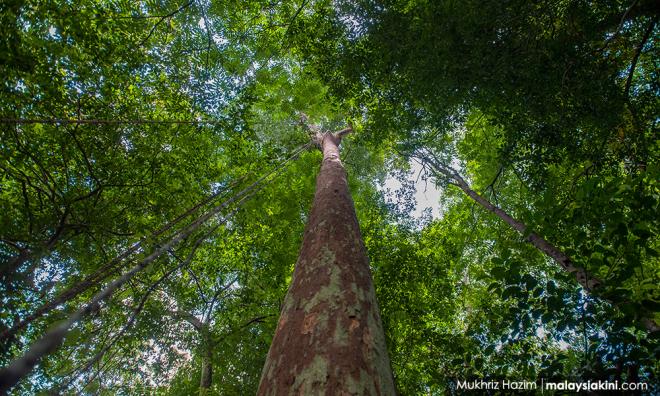
Ravaged by mining and logging, Perak forest now threatened by farming
A forest reserve in Perak, which is part of a key wildlife corridor in Peninsular Malaysia, is now being threatened by plans to develop monoculture farming there.
Last week, Perak Menteri Besar Ahmad Faizal Azumu said three companies had received permits to develop 400 hectares in the Piah Forest Reserve, pending environmental impact assessments.
Environmental group Sahabat Alam Malaysia (SAM) said monoculture farming will be yet another blow to the forest reserve in Lenggong which has already been ravaged by mining and logging activities.
The permits have been issued despite the reserve being part of the Central Forest Spine - a network of four main forest complexes which supplies 80 percent of the water supply in Malaysia and is a habitat to various endangered wildlife such as the Malayan tiger.
SAM advisor Meor Razak Meor Abdul Rahman said that although the law permits parts of forest reserves to be used for agriculture, mining, and logging, those activities can have an irreversible impact on the environment.
“All parties should know that when a forest complex, especially one that is protected and has “security of tenure”, is exploited through logging and other damaging activities, the forest’s functions will be affected.
“This means the goals of forest management, which is the core of national resource management, too will be affected,” he said.
Most of Piah Forest Reserve can be logged or mined
According to the National Forestry Act, forest reserves can be classified for different usages, including for “production” under which forest products like timber and minerals can be legally harvested. Parts of the forest reserve can also be used for agricultural purposes.
Meor said that out of the Piah Forest Reserve’s 72,190.46 hectares, only 17,107 hectares (23 percent) are gazetted as catchment areas.
The remaining are classified as “production” forest, including parts which were previously classified as virgin jungle reserve.
Last week, Perak Menteri Besar Ahmad Faizal Azumu said three companies had received permits to develop 400 hectares in the Piah Forest Reserve, pending environmental impact assessments.
Environmental group Sahabat Alam Malaysia (SAM) said monoculture farming will be yet another blow to the forest reserve in Lenggong which has already been ravaged by mining and logging activities.
The permits have been issued despite the reserve being part of the Central Forest Spine - a network of four main forest complexes which supplies 80 percent of the water supply in Malaysia and is a habitat to various endangered wildlife such as the Malayan tiger.
SAM advisor Meor Razak Meor Abdul Rahman said that although the law permits parts of forest reserves to be used for agriculture, mining, and logging, those activities can have an irreversible impact on the environment.
“All parties should know that when a forest complex, especially one that is protected and has “security of tenure”, is exploited through logging and other damaging activities, the forest’s functions will be affected.
“This means the goals of forest management, which is the core of national resource management, too will be affected,” he said.
Most of Piah Forest Reserve can be logged or mined
According to the National Forestry Act, forest reserves can be classified for different usages, including for “production” under which forest products like timber and minerals can be legally harvested. Parts of the forest reserve can also be used for agricultural purposes.
Meor said that out of the Piah Forest Reserve’s 72,190.46 hectares, only 17,107 hectares (23 percent) are gazetted as catchment areas.
The remaining are classified as “production” forest, including parts which were previously classified as virgin jungle reserve.

Meor Razak Meor Abdul Rahman
“Within the 55,083.46 hectares classified for “timber production forest under sustained yield”, parts are already and will be exploited for monoculture farming and quarries,” he said.
Monoculture farming, such as the mass planting of fruit trees including the popular musang king, has previously been blamed for the obliteration of biodiversity in forest complexes in Kelantan.
“When a forest ceases to be a permanent reserve, and a reserve then becomes a monoculture farm, the original forest cover would be completely logged.
“This logging is not controlled by sustainable forest management principles, the Semenanjung Malaysia Annual Allowable Cut for Permanent Reserved Forest, or the Malaysia Criteria and Indicators for Sustainable Forest Management,” he said.
This means that, although a portion of the forest reserve is still considered a "forest" on paper, it no longer functions as one - it no longer performs a forest's functions such as being a carbon sink, a water catchment, and a wildlife corridor.
Monoculture plantations within forests can also cause wildlife to search elsewhere for food and shelter, causing them to venture onto highways or areas populated by humans, leading to human-wildlife conflict.
Besides Perak and Kelantan, Pahang, Kedah and Terengganu are also looking at using its forest reserves for monoculture farming.
Monoculture farming, such as the mass planting of fruit trees including the popular musang king, has previously been blamed for the obliteration of biodiversity in forest complexes in Kelantan.
“When a forest ceases to be a permanent reserve, and a reserve then becomes a monoculture farm, the original forest cover would be completely logged.
“This logging is not controlled by sustainable forest management principles, the Semenanjung Malaysia Annual Allowable Cut for Permanent Reserved Forest, or the Malaysia Criteria and Indicators for Sustainable Forest Management,” he said.
This means that, although a portion of the forest reserve is still considered a "forest" on paper, it no longer functions as one - it no longer performs a forest's functions such as being a carbon sink, a water catchment, and a wildlife corridor.
Monoculture plantations within forests can also cause wildlife to search elsewhere for food and shelter, causing them to venture onto highways or areas populated by humans, leading to human-wildlife conflict.
Besides Perak and Kelantan, Pahang, Kedah and Terengganu are also looking at using its forest reserves for monoculture farming.
*********
kt notes:
Mono-culture is bad because it involves reusing the exact same soil,thus it can lead to plant pathogens and diseases.
We can trust Azumu to eff up Perak's forest reserves. Apart from "hugging" the trees (all the way to the timber mills), he continues to eff up Aborigines' assets and adversely affect their way of life and livelihood.
I continue to be baffled by HRH's choice of this treacherous snake (from a kutu party) to be MB of his State.
mono culture mean kelapa sawit? then shd be fine. forest reserve is a western lie that wanna keep us poor.
ReplyDeleteThe worst culprit is actually Penang, not Perak.
ReplyDeleteThere is virtually ZERO pristine jungle left in Penang.
Illegal farmers and squatters think it is their "RIGHT" to take over Government forest reserve, because it is so difficult to obtain proper permission to farm government forest land.
After a few years, they have effectively appropriated the land, because they say they have put in so much work to cultivate the land, they have the RIGHT to that land.
Add to that DAP government reluctance to take stern action against illegal farmers, means it is almost open season on whatever little jungle cover remains in Penang.
Rubbish, Penang Island (not Mainland) has one of the oldest (at least 130 million years old) rainforest in the world.
DeleteRead https://www.eurekalert.org/pub_releases/2017-12/caos-nsd120617.php
Extracts:
The rainforest on the island of Penang encompasses a series of hills overlooking the modern metropolis of George Town and is thought to be 130 million years old. It is considered primary forest since it has never been cut down before.
19,768
The biodiversity survey occurred within The Habitat and the adjacent Bukit Kerajaan Forest Reserve, which was originally established as a Virgin Jungle Reserve in 1911. Contiguous forest reserves, water catchment reserves, and Penang National Park together comprise approximately 19,768 acres (or 8,000 hectares). Regional partners continue to advocate for rainforest conservation in Penang, Malaysia at large, and the world.
5236
Tree-climbing scientists from the Academy, UC Berkeley, The Tree Projects, and other partner organizations climbed 5236 vertical feet during this first-ever canopy survey in Malaysia. Over half of any forest's biodiversity lives in the canopy, making the treetops a critical and often overlooked area of study. Scientists climbed several rare and endangered tree species on Penang Hill to document the orchids, ferns, and epiphytes (or air plants) thriving at such heights and to press leaf samples for further study. Fifty-nine mammals were also documented through motion sensitive cameras, including lively macaques, dusky-leaf monkeys, tree rats, and flying squirrels (images available upon request).
1424+
Over 1400 species were recorded via iNaturalist, the nature-tracking mobile app that uses a community of online experts to confirm observations. This number will continue to climb as participants process observations in the coming months.
47
A combined forty-seven students from local schools, World Wildlife Fund Hong Kong, and JASON Learning met scientists in the field to experience fieldwork firsthand. Daily video dispatches (courtesy of JASON Learning) earned over 3,000 unique viewers from around the globe on YouTube and 69,000 unique viewers on Facebook.
25
At least twenty-five plants and animals observed during the survey are new records for Penang Hill, the island of Penang, or peninsular Malaysia, including the Sunda colugo or flying lemur, the red giant flying squirrel, the long-tailed giant rat, the Indomalayan niviventer, the lesser mouse deer, and species of ground squirrels, birds, bacteria, bats, ants, orchids, flies (including two mosquitoes), frogs, and microscopic water bears.
4
Four species found during the survey are likely new to science (a scorpion, fly, bacterium, and water bear). However, confirming species discoveries takes months and oftentimes years as scientists carefully sort, study, compare, describe, and potentially revise their contributions to the tree of life.
1
One thriving rainforest up for UNESCO nomination.
https://rexymizrah.wordpress.com/2016/08/27/forest-reserves-in-penang-under-increasing-threat-of-encroachment/
DeleteThe reality on the ground...
Plenty of uncontrolled illegal farming..
KT insulted the Perak Sultan on his choice of MB. Shame on him.
ReplyDelete